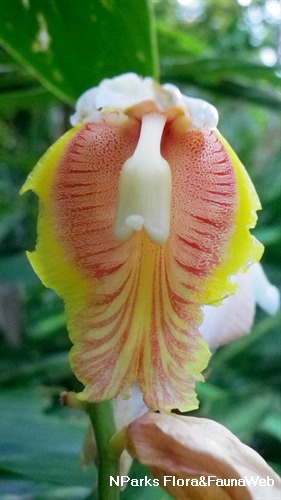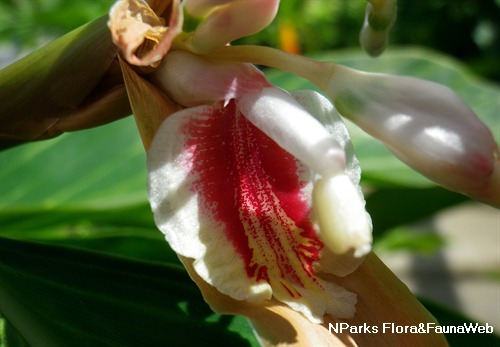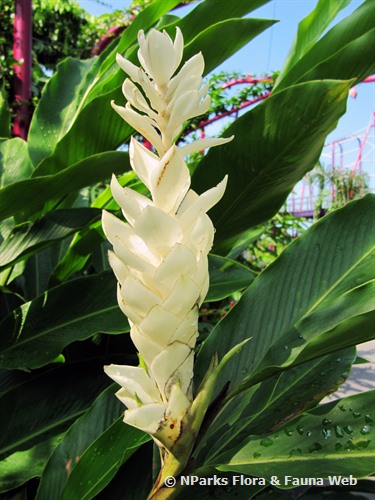
Back
Alpinia zerumbet (Pers.) B.L.Burtt & R.M.Sm.
| Family Name: | Zingiberaceae |
| Synonyms: | Costus zerumbet Pers., Alpinia nutans var. longiramosa Gagnep., Alpinia speciosa (J.C.Wendl.) K.Schum., nom. illeg., Alpinia cristata Griff., Alpinia fimbriata Gagnep., Alpinia fluvitialis Hayata, Alpinia schumanniana Valeton, Amomum nutans (Andrews) Schult., Catimbium speciosum (J.C.Wendl.) Holttum, Languas schumanniana (Valeton) Sasaki, Languas speciosa (J.C.Wendland) Small, Renealmia nutans Andrews, Renealmia spectabilis Rusby |
| Common Name: | Shell Ginger, Shell Flower, Light Galangal, Pink Porcelain Lily |
The Shell Ginger (Alpinia zerumbet) is a herbaceous perennial with erect, pseudostems growing up to 2 - 3 metres tall. It is named after the unopened flower buds that resemble pink seashells. While grown in Singapore as an ornamental, the leaves are used as food wrappers in other countries and to flavour ice cream, teas, and seasoning in Japan.
Name
Classifications and Characteristics
| Plant Division | Angiosperms (Flowering Seed Plants) (Monocotyledon) |
|---|---|
| Plant Growth Form | Herbaceous Plant |
| Lifespan (in Singapore) | Perennial |
| Mode of Nutrition | Autotrophic |
Biogeography
| Native Distribution | Northeastern India, China, Japan, Myanmar, Cambodia, Laos, Vietnam, Thailand |
|---|---|
| Native Habitat | Terrestrial (Secondary Rainforest, Primary Rainforest) |
| Preferred Climate Zone | Tropical |
| Local Conservation Status | Non-native (Horticultural / Cultivated Only) |
Description and Ethnobotany
| Growth Form | It is a rhizomatous, herbaceous perennial that grows in upright clumps up to 2 - 3 m tall. |
|---|---|
| Foliage | The leaves are green, leathery, oblong to oblong-lanceolate, growing up to 30 - 70 cm long and 5 - 14 cm wide. The margin is usually entire and brownish. The leaves are arranged alternately in two ranks, i.e. distichously. |
| Stems | The erect aboveground 'stems' are pseudostems, a shoot formed from a series of leaf sheaths tightly wrapped around one another, and can reach 2 - 3 m tall. The true stems are underground ginger-like rhizomes (thick, horizontal modified stems). |
| Flowers | The inflorescence is a pendulous raceme growing at the terminal end of the leafy shoots. Individual flowers are fragrant, bilaterally symmetrical, and tubular, composed of a white calyx, a shorter corolla tube with milky white, pink-tipped lobes, and a distinct yellow lip with an orange-red center. |
| Fruit | The fruit is a round capsule (a type of dry, dehiscent fruit), usually light orange to orange-yellow. |
| Habitat | It can be found in secondary vegetation, bamboo and teak forests, brushwood and ravines, often in shady conditions and rarely in primary rainforest. |
| Cultivation | It grows well in moist, well-drained, fertile soil, and bright, direct or indirect sunlight or under dappled shade. It can be propagated by seed, and division via rhizomes. |
| Etymology | The genus Alpinia is named in honour of Prosper Alpino (1553 - 1617), an Italian botanist who introduced coffee and bananas to Europe. The specific epithet zerumbet refers to an Indian vernacular name of Arabic origins for likely, Zingiber zerumbet. The common name 'Shell Ginger' refers to the flower bud's resemblance to pink sea shells. |
| Ethnobotanical Uses | Food (Fruit or Vegetable): In parts of Malaysia, the piths of young stems are chopped and stir-fried or eaten raw in salads. (Herb or Spice): In Japan, the leaves are used to flavour ice cream, teas, and seasonings. Medicinal: In Asia and South America, different parts of the Shell Ginger is used in traditional medicines to treat a wide variety of conditions, such as cold, fever, malaria, digestive issues, and high blood pressure. It is important to note that some therapeutic effects from traditional medicinal uses of plants are not currently supported or verified by scientific research. Timber & Products: In eastern Asia, leaf sheaths are a source of fibre for rope, while paper is made from the whole plant, although these uses are only of local importance and mainly used in times of scarcity. Others: In Japan, the leaves are used to wrap cakes, bread, and other goods to protect them from high humidity and temperature. In China, the dried leaves are used as a food wrapper (traditionally made from bamboo leaves) for glutinous rice dumplings. In Ambon, the leaves are also used as wrappers for cooked rice to impart a fine smell. |
Landscaping Features
| Desirable Plant Features | Ornamental Flowers, Fragrant (Flowers), Ornamental Form |
|---|---|
| Landscape Uses | General, Suitable for Roadsides, Parks & Gardens, Flowerbed / Border, Container Planting |
| Thematic Landscaping | Economic Garden, Fragrant / Aromatherapy Garden |
Plant Care and Propagation
| Light Preference | Semi-Shade, Full Sun |
|---|---|
| Water Preference | Lots of Water |
| Plant Growth Rate | Fast to Moderate |
| Rootzone Tolerance | Moist Soils, Well-Drained Soils, Fertile Loamy Soils |
| Transplanting Tolerance | Moderate |
| Maintenance Requirements | Low |
| Pest(s) | Chewing Insects |
| Propagation Method | Seed, Division, Storage Organ (Rhizome) |
Foliar
| Foliage Retention | Evergreen |
|---|---|
| Mature Foliage Colour(s) | Green |
| Mature Foliage Texture(s) | Smooth, Leathery |
| Foliar Type | Simple / Unifoliate |
| Foliar Arrangement Along Stem | Alternate |
| Foliar Attachment to Stem | Petiolate |
| Foliar Shape(s) | Non-Palm Foliage (Elliptical, Oblong) |
| Foliar Venation | Pinnate / Net |
| Foliar Margin | Entire |
| Foliar Apex - Tip | Acuminate |
| Foliar Base | Attenuate |
| Leaf Area Index (LAI) for Green Plot Ratio | 3.5 (Shrub & Groundcover - Monocot) |
Non - Foliar and Storage
| Stem Type & Modification | Herbaceous, Pseudostem |
|---|---|
| Root Type | Underground (Fibrous Root) |
| Specialised Storage Organ(s) | Underground (Rhizome) |
Floral (Angiosperm)
| Flower & Plant Sexuality | Bisexual Flowers |
| Flower Colour(s) | White, Pink |
|---|---|
| Flower Texture(s) | Smooth, Leathery |
| Flower Grouping | Cluster / Inflorescence |
| Flower Location | Terminal |
| Flower Symmetry | Bilateral |
| Individual Flower Shape | Tubular |
| Inflorescence Type | Raceme |
| Ovary Position | Inferior / Epipgynous |
| Flowering Habit | Polycarpic |
Fruit, Seed and Spore
| Mature Fruit Colour(s) | Orange |
|---|---|
| Fruit Classification | Simple Fruit |
| Fruit Type | Dehiscent Dry Fruit , Capsule |
References
| References | Datiles, M.J., Alpinia zerumbet (shell ginger). In: CABI Compendium. Wallingford, UK: CAB International. https://www.cabidigitallibrary.org/doi/full/10.1079/cabicompendium.109799 (Accessed 11 April 2025) Mulyati Rahayu, N. & Halijah Ibrahim. (1999). Alpinia Roxburgh. Plant Resources of South-East Asia No 19: Essential-oil plants. PROSEA Foundation, Bogor, Indonesia. |
|---|
Image Repository
Others
| Master ID | 354 |
|---|---|
| Species ID | 1650 |
| Flora Disclaimer | The information in this website has been compiled from reliable sources, such as reference works on medicinal plants. It is not a substitute for medical advice or treatment and NParks does not purport to provide any medical advice. Readers should always consult his/her physician before using or consuming a plant for medicinal purposes. |




